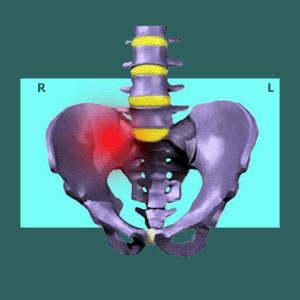
Right side sacroiliac pain describes unilateral symptoms which are expressed on the right side of the pelvic anatomy only. Right sided symptoms are slightly less common statistically, possibly providing some clues about the reasons why some people develop pain in a specific side of the SI joint structure in the first place.
Many patients write to us asking why they have pain on the right side of the sacroiliac, but not on the left. Unfortunately, there is no universally applicable answer that will apply to all cases. However, these questions have given us the incentive to track the various statistics of right sided SIJ pain syndromes and it is our pleasure to share these findings with you to assist in your own research needs.
This short and simple essay investigates right sided sacroiliac joint pain conditions. We will provide some statistics gathered over many years of research and clinical experience, as well as share some theories as to why these statistics might be relevant.
Right Side Sacroiliac Pain Statistics
In our research, we have discovered that 65% of unilateral sacroiliac joint pain conditions exist in the left side of the body, rather than the right, which only accounts for about 35% of all unilateral SIJ syndromes. We must also note that approximately 12% of the total population is left-handed, making 88% right side dominant. This statistics might mean that people are more susceptible to sacroiliac joint problems on their less dominant side of the body.
Furthermore, we also discovered that patients who demonstrate right side SIJ pain conditions have a fair chance (about 20% to 25%) of developing similar symptoms in the left side, as well as, or eventually after the right side is successfully treated. There are many possible reasons for this occurrence to exist.
Right Leg SIJ Pain Interpretation
It does seem that people are more prone to developing all manner of sacroiliac joint diagnoses on their non-dominant side. However, since the statistics are not truly conclusive in this regard, we will explain this occurrence as a theory only and not proven by any scientific means except clinical observation. We do not have any evidence of why this might occur, although some physical therapists have proposed ideas relating to greater degree of weight bearing and physical exertion on the dominant side versus the weaker side of the pelvic anatomy. Other therapists have suggested that the SI joint actually develops differently in the less dominant side early in life.
As to why patients might develop pain bilaterally, or pain that switches to the left side, we have many theories. A compromised right sacroiliac joint will certainly create more stress for the left side of the anatomy, potentially leading to injury or accelerated degeneration. These problems might occur quickly, resulting in bilateral pain conditions simultaneously, or might occur and only become symptomatic with time, explaining why some patients are successfully treated for right sided pain before the left side becomes symptomatic.
However, the possibility that one or both sides are simply psychogenic pain conditions can not be left out of consideration. Mindbody pain syndromes tend to spread to new areas upon successful treatment or upon any nocebo influence that might suggest the possibility of accelerated degeneration or chance for injury to the previously unaffected side of the SIJ. These possibilities should certainly be tested, since many patients can be successfully and permanently cured using knowledge therapy, rather than drug, injection or surgical methods of care that act as nothing more than placebo treatments in cases of psychogenic pain.
Sacroiliac Joint Pain > Sacroiliac Pain > Right Side Sacroiliac Pain




